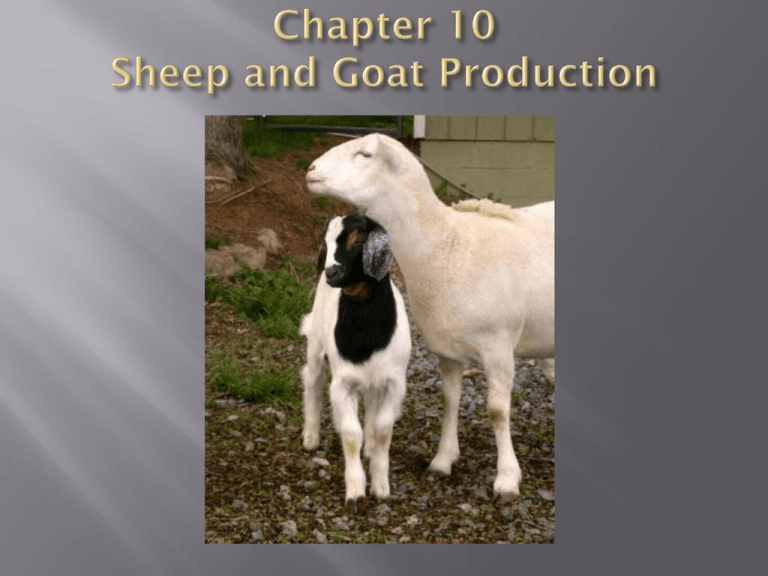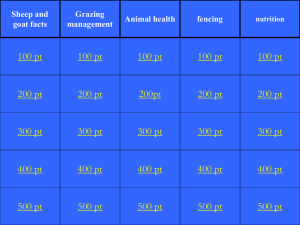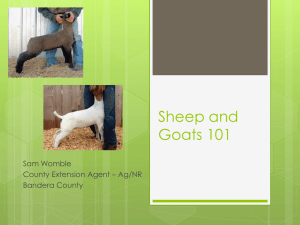
Look similar
Ruminants
Goats have beards
Sheep have foot glands
Male goats have a strong smell
Slight differences in horns and skeleton
Goats are more intelligent, independent and
have a better ability to fight and protect
themselves.
Goats were first to be domesticated
Goats skins were once used for bottles
Sheep and goats are used for food and fiber
Both were used to plant seed by trampling
them into the ground.
Raised for food and Clothing
Goats domesticated 9000 years ago
Sheep domesticated 8000 years ago
Sheep originated in Asia and Europe
Goats originated in Mediterranean area and Asia
Brought to America 400 years ago
Australia and New Zealand lead in producers of sheep
New Zealand people consume around 60 pounds of sheep per
year.
The world consumption is around 3 pounds per year
China and India are the leading producers of Goats
These two countries produce 460 million head
North America only produces 2.5 million; numbers have
declined due to lower returns, predators, high risks, high
wages, and uncertain prices.
Goat numbers have increased in the 2000’s
USA ranks 27th in sheep numbers. The largest sheep numbers
are in Texas
Food
Lamb – meat from a young
sheep less than one year old.
Mutton – is meat from a sheep
that is more than one year old.
Mutton has a strong flavor –
less desirable.
Goat Meat – Chevron
Milk – from goats (not
common from sheep), has
small particles known has
globules.
Milk products – cheese
(Roquefort)
Clothing:
Wool – soft cloth of
sheep
Mohair and
Cashmere – from
specific goats
Sheep yield 5-15
pounds per shearing
Hides are used for
leather products
called – Chammy
More suitable for range land
Excellent scavengers
Sheep more efficient in
converting feed to meat than
cattle
Dual purpose animal
producing meat and fiber
Yield fast returns – 8 months to
raise
Sheep and goats can be
pastured together
Goats eat browse (woody
plants)
Sheep graze on short grass and
some broadleaf plants
Don’t have a huge waste
disposal problem
Don’t need elaborate facilities
Price of wool is low and
unstable
Synthetic fibers has hurt
the industry
Consumption of lamb is
low
Susceptible to disease and
parasites
Susceptible to attack from
predators
Ruminants
Cloven hoofs
(divided)
Classified in the
Bovidae family
Sheep are more
economically
important than goats
in the USA
Goats:
Goats range from 20 (dwarf)
to 150 pounds
Goat height 1.5 -4 feet
Goats live 8-10 years
Sheep:
Sheep range from 100-225
pounds
Wool on a large sheep
weighs 15 pounds
Sheep live 7-13 years
Lamb – young sheep or either
sex and less than one year old
Ewe – female sheep any age
Ram – male sheep kept for
breeding not castrated
Wether – castrated male sheep
or goat before maturity
Nanny – doe or female goat
Buck or Billy – male goat not
castrated
Kid – young goat under a year
of age
Breeding season for goats is regulated by the
climate and season.
Hot climates – goats mate year round
In climates away from the equator goats mate
typically in late summer and fall
Goats (does) are breed to have their young at
two years of age
Process of giving birth in goats – kidding
Kids weigh around 5 pounds
Goats typically have 2-3 kids per litter
Gestation period for a goat is 151 days
Gestation period for a sheep is 148 days
Estrus cycle for goats are 18 – 19 days
Estrus cycle for sheep is 16-17 days
Heat period for sheep is 30 hours (no visible
signs)
Goats require very little shelter
If eaten should be
muscular, health,
strong and sound.
Over 200 breeds of
domestic sheep are in
existence today. ¾ of the
sheep raised come from
these sheep listed - Suffolk,
Dorset, Hampshire,
Rambouillet, Polypay, and
Columbia. North America
includes – Oxford,
Southdown, Corriedale,
Montadale, Shropshire,
Cheviot, and Katahdin.
Over 300 breeds of domestic
goats are known. Domestic goats
are in five groups.
Angora – Used for angora fiber
Dairy – 1.8% of world supply of
milk. Average doe produces 5
pounds per day (for 10 months)
Meat – Spanish goat and boar
goat – don’t compete for grass,
but rather prefer browsing.
Cashmere – finest animal fiber
used. 3 times the insulating value
of wool.
Pygmy – used for research and
pets
80 % Meat and 20 % Fiber Wool
Selection – important for
production goals
Production Systems:
Farm Flock – most popular
method
Purebred Flock – Pure Blood
lines, lots of labor
Range Band Method – a band of
sheep with it’s own herder
Confinement Method – becoming
popular. Less parasites, land
needed, less death.
Ewes reach puberty at 8-10
months
Rams reach puberty at 5-7
months
Ewes give birth at 24 months
Giving birth in sheep is called –
lambing
Ewe Management
Care at lambing / orphan lambs
Docking – 3-10 days
Castration – 3-10 days
Nutritional needs – all six nutrients
Feeding – concentrates verse
roughages (do better on these)
Prevention key to
successful
practices Sanitation
Sheep need housing
Fencing – woven wire
Equipment – loading
chutes, crates
Exercise tracks
Showing animals – Fitting
and Showing
Goats have a leash
Sheep are shown without
equipment










